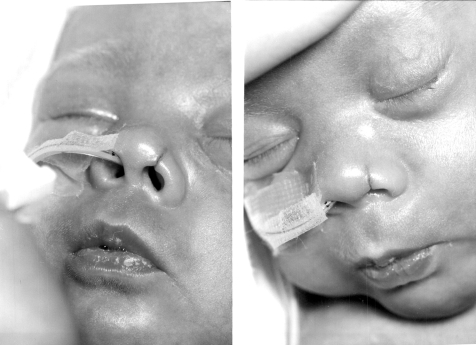We would like to report a preterm baby, who sustained a major nasal injury secondary to nasal continuous positive airway pressure (nCPAP). The baby was extremely low birth weight and needed CPAP for 3 weeks. The baby developed laceration of the alae nasi within a week (fig 1). The laceration was 1 cm in size, causing division of the alae nasi on the medial side. The tear took 4 weeks to heal after nCPAP. This baby had recovered well from the nasal injuries at the time of discharge.
Figure 1 Baby with laceration of alae nasi. Informed parental consent was obtained for publication of this figure.
nCPAP is a common mode of respiratory support used in neonatal intensive care units. Elective use of nCPAP has helped to reduce the incidence of failed extubation. The nasal trauma was caused by nasal prongs and has been reported as 20%.1A recent randomised control study by Yong et al2 found a higher incidence of nasal trauma due to CPAP and also found that that there was no significant difference in nasal trauma between prongs and mask. The nasal injuries reported in the literature range from redness, erythema, crusting and excoriation to scaling. The common sites for injuries are the base of the septum, where it meets the philtrum, caused by the mask, and the medial aspect of the septum, caused by the prongs. Duration of nCPAP is a definite risk factor for nasal trauma. Birth weight, gestation and type of nasal device are not significant.
Footnotes
Competing interests: None declared.
References
- 1.Robertson N J, McCarthy L S, Hamilton P A.et al Nasal deformities resulting from flow driver continuous positive airway pressure. Arch Dis Child Fetal Neonatal Ed 199675F209–F212. [DOI] [PMC free article] [PubMed] [Google Scholar]
- 2.Yong S‐C, Chen S‐J, Boo N‐Y.et al Nasal trauma associated with nasal prong versus nasal mask during continuous positive airway pressure treatment in very low birth infants. Arch Dis Child Fetal Neonatal Ed 200590F480–F483. [DOI] [PMC free article] [PubMed] [Google Scholar]



